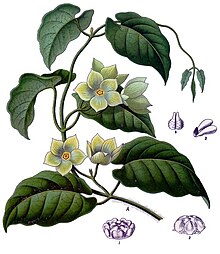
Back صقلابيات Arabic Ластаўневыя Byelorussian Asclepiadòidies Catalan Seidenpflanzengewächse German Asclepiadoideae Spanish استبرق (زیرتیره) Persian Asclepiadoideae French Svileničevke Croatian Łastojčnikowe rostliny HSB Asclepiadoideae Italian
| Asclepiadoideae | |
|---|---|

| |
| Matelea denticulata[1] | |
| Scientific classification | |
| Kingdom: | Plantae |
| Clade: | Tracheophytes |
| Clade: | Angiosperms |
| Clade: | Eudicots |
| Clade: | Asterids |
| Order: | Gentianales |
| Family: | Apocynaceae |
| Subfamily: | Asclepiadoideae Burnett |
| Genera | |
|
See text | |
The Asclepiadoideae are a subfamily of plants in the family Apocynaceae. Formerly, it was treated as a separate family under the name Asclepiadaceae, e.g. by APG II, and known as the milkweed family.[2][3]
They form a group of perennial herbs, twining shrubs, lianas or rarely trees but notably also contain a significant number of leafless stem succulents. The name comes from the type genus Asclepias (milkweeds).
There are 348 genera, with about 2,900 species. They are mainly located in the tropics to subtropics,[4] especially in Africa and South America.
The florally-advanced tribe Stapelieae within this family contains several relatively familiar stem succulent genera, such as Orbea, Huernia, Stapelia and Hoodia. They are remarkable for the complex mechanisms which they have developed for pollination, independently parallel to the unrelated Orchidaceae, such as the grouping of their pollen into pollinia. The "fragrance" (or odor) of the flowers, often called "carrion flowers", attracts flies, the chief pollinators for these plants. Additionally, the color, appearance and texture of the flowers often is thought to resemble decaying flesh or raw meat to further entice pollination by flies.
Many new hybrids have been formed due to the unique fertilization method of the flowers.
- ^ 1897 illustration from Franz Eugen Köhler, Köhler's Medizinal-Pflanzen
- ^ English Names for Korean Native Plants (PDF). Pocheon: Korea National Arboretum. 2015. p. 363. ISBN 978-89-97450-98-5. Archived from the original (PDF) on 25 May 2017. Retrieved 25 January 2017 – via Korea Forest Service.
- ^ Endress, M. E. and P. V. Bruyns (2000), "A revised classification of the Apocynaceae s.l." (PDF), Botanical Review, 66 (1): 1–56, Bibcode:2000BotRv..66....1E, doi:10.1007/BF02857781, S2CID 31739212
- ^ Spellenberg, Richard (2001) [1979]. National Audubon Society Field Guide to North American Wildflowers: Western Region (rev ed.). Knopf. p. 347. ISBN 978-0-375-40233-3.
© MMXXIII Rich X Search. We shall prevail. All rights reserved. Rich X Search